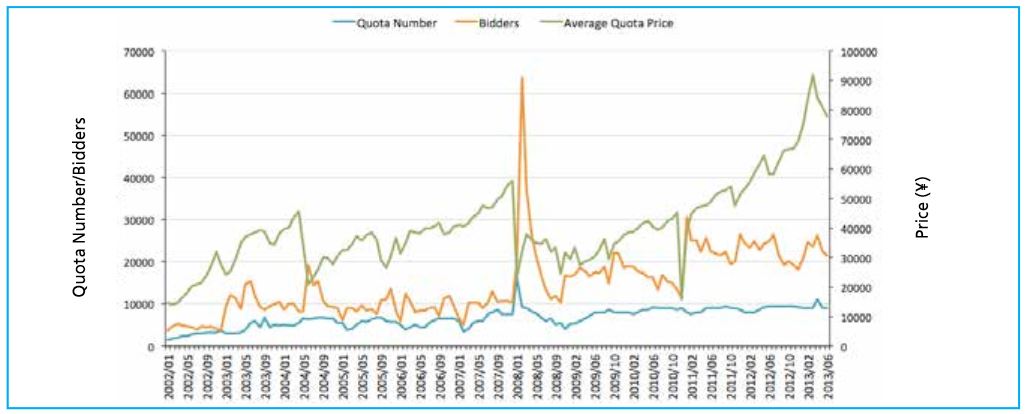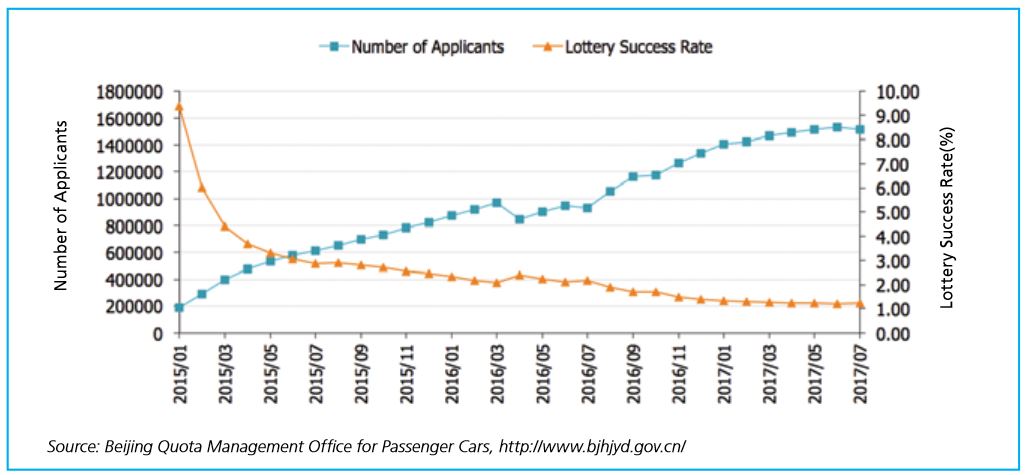Last week’s blog ended with the following promise: “… a few of the largest cities in China are now taking drastic steps to limit car ownership – a fact that I was completely unaware of until my visit.” Time to unveil the mystery and go to some detail. Cities such as Shanghai, Beijing, Guangzhou and now Shenzhen have decided to limit car ownership – not through any direct regulation or by imposing a tax on car ownership, but instead by making the license plates very expensive. I was told about the practice by our Chinese guide when we visited the first two cities and I was shocked. I was told that the licensing fee can cost as much as the car itself (it also applies to motorcycles). I had never heard about the practice, but immediately recognized its benefits to limiting the number of automobiles in a city. Also, as long as you don’t differentiate between imported and domestically manufactured cars you are not running up against any international trade agreements. The data for the first three cities is given in the three figures below:
 Figure 1 – The number of registered automobiles (in 10,000’s) of Beijing, Shanghai and Guangzhou
Figure 1 – The number of registered automobiles (in 10,000’s) of Beijing, Shanghai and Guangzhou
 Figure 2 – The quota, average price and bidders for Shanghai licence plates (2002/01-2013/06)
Figure 2 – The quota, average price and bidders for Shanghai licence plates (2002/01-2013/06)
 Figure 3 – The quota and lottery success rate in Beijing (2011/01-2013/07)
Figure 3 – The quota and lottery success rate in Beijing (2011/01-2013/07)
Figure 1 shows the rise in car ownership per resident in the three cities. It shows an uninterrupted growth from the time of my first visit (1992). The attempt to restrict car ownership through limiting the numbers of new license plates started at the tail end of this graph, between 2008 and 2011. Many cities in the developed world use policies including construction of more efficient public transportation to curb the use of cars. Once the Chinese realized that such measures were not sufficient for their purposes, some of its cities started to implement more austere restrictions. For various reasons, including the country’s accelerated urbanization and the perceived status enhancement associated with the purchase of a car, people have kept buying them as they acquire the financial means to do so.
Unsurprisingly, the attempts to limit car ownership through license plate restrictions started in Shanghai and Beijing – China’s two largest cities (details are taken from the Feng and Li article that I cited previously). Shanghai was the first city to implement a policy to control car ownership through an auction process. The policy started in 1986 but only reached full force by early 2000.
The auction opens to the public once a month. In recent years the quota has fluctuated between 8,000 and 9,000 license plates per month. The number of quotas/bidders together with the average price in the Shanghai bidding is shown in Figure 2. While the auction mechanism clearly limits the number of license plates, it also inherently restricts car ownership to rich owners.
During the 2008 Olympic Games in Beijing, driving restrictions were put into place in Beijing based on license plate numbers: the right to drive on any given day alternated according to odd or even numbers on the plates. After the Olympics the policy was modified to require that every car (again, based on its license plate number) be off the road at least one day a week. In the beginning of 2011 Beijing decided to expand the restrictions and follow Shanghai in implementing a quota, but tried a different tactic – namely, distributing the quota by lottery. Figure 3 shows the quota success rate in Beijing – it documents a steady rise in applications coupled with a steady decline in the success rate.
Two clear trends are visible through these descriptions: the decision process over how best to limit car ownership is local, and as result the various cities’ methods serve as experimental examples of the most effective (and fair?) mechanisms to limit car ownership in cities. Unfortunately, another impact of this highly localized approach is that it leaves itself open to work-arounds and fraud.
Some of these schemes are described in the Feng and Li article, while others are described elsewhere. Here are some of the techniques, as well as attempts that are being taken to mediate their impact.
- Since the license plate restriction policy only applies in a few cities, people register in another city and drive from there to their final destination/residence. In response, Shanghai (and presumably the other three cities as well) have started to restrict the driving of cars (mainly during peak hours) with non-local registration plates.
- It is not surprising that since license plates are becoming expensive and scarce a very active secondary market is developing in these cities. To try to cut down on the quick turnaround, Shanghai, for example, requires that license plate owners keep them for three years before selling them.
- One reported scam that tries to work around the restrictions is a collusion between the owner and buyer of secondary cars. The two parties construct an imaginary debt that the seller “owes” the buyer for which the car is used as “collateral.” The seller “defaults” on the loan. They both go to court and the “debtor,” who is actually the car owner, is ordered to hand over the car to the “lender,” the car’s buyer. Along with this transfer of ownership comes the already registered license plate.
- Another option is to obtain temporary plates by leasing them from a car rental companies. Rental agencies can charge sums equivalent to $500/month for the rent.
Revenues from the taxes are used to improve mass transit and transportation infrastructure.
In principle, if not in detail, China’s new techniques resemble the more widely known structure of cap-and-trade with regards to pollution rights. The key in both techniques is to set a fixed number of cars that that can be driven or total acceptable emissions.
China’s cities have a lot of reasons to want to avoid exceeding the “saturation range” that I discussed in last week’s blog. These include their inability to manage heavier traffic and increasing demands on parking, as well as their desire to minimize China’s contributions to greenhouse gas emissions overall. Meanwhile, from China’s perspective, one of the most urgent driving forces is the need to minimize its infamously bad air pollution. I will discuss this topic in next week’s blog.

It’s fascinating to see how cities like Shanghai, Beijing, Guangzhou, and Shenzhen are tackling car ownership by making license plates costly. This indirect method is an interesting approach, steering people away from owning cars without the need for strict regulations or taxes. https://sterinoxsystems.com/
This is a fascinating look at how major cities in China are tackling car ownership through innovative measures like expensive license plates. It’s intriguing to see how these methods not only address traffic congestion but also contribute to environmental goals. As cities worldwide face similar challenges, there’s much to learn from these approaches.
For anyone interested in stylish and sustainable living, be sure to check out https://pellepellestore.to for some amazing leather jackets that complement an eco-conscious lifestyle!
There should be a limit of usable cars based on their emissions. All countries must invest heavily in their public transport. And people should be using more car sharing/renting services. https://cria.al
Wow, it’s fascinating to see how China is tackling the challenge of car ownership in its major cities! The approach of making license plates expensive to limit ownership is a unique one, especially considering the creative workarounds people have come up with. It’s like a whole new market of ingenuity and problem-solving. And it’s great to hear that the revenue from these measures is being reinvested into improving mass transit and infrastructure. It’s a reminder that sometimes unconventional solutions can lead to positive outcomes for everyone. Speaking of innovative solutions, if you’re looking for some stylish threads to match this forward-thinking mindset, don’t forget to check out Pelle Pelle Store for some cool options! Explore here: https://pellepellestore.com/
Nice website guys
The rise in the number of vehicles leads to a corresponding surge in pollution and contributes significantly to climate change.
Great blog. Excellently written.
your site is very nice
The increase in vehicles results in an increase in pollution and great climate change.it should be stopped I guess. I t is a big probem
The increase of vehicles results in an increase in pollution and great climate change.
Very Detailed Article.
The increase in vehicles results in an increase in pollution and great climate change.it should be stopped I guess
Climate Change has become the biggest problem in the world.
There are three major factor to reduce the numbers of cars.
1-Investment in public sector to avoid as much as we can the personal vehicle.
2-Invest in technologies that can reduce the cost and insincere the autonomy of a electric vehicles.
3-Car sharing or rental car, so basically you use the car when and where you need it no need to have your own car.
This is for biggest country’s that have great impact
https://rentacaralbania.com
The increase of vehicles results in an increase in pollution and great climate change.